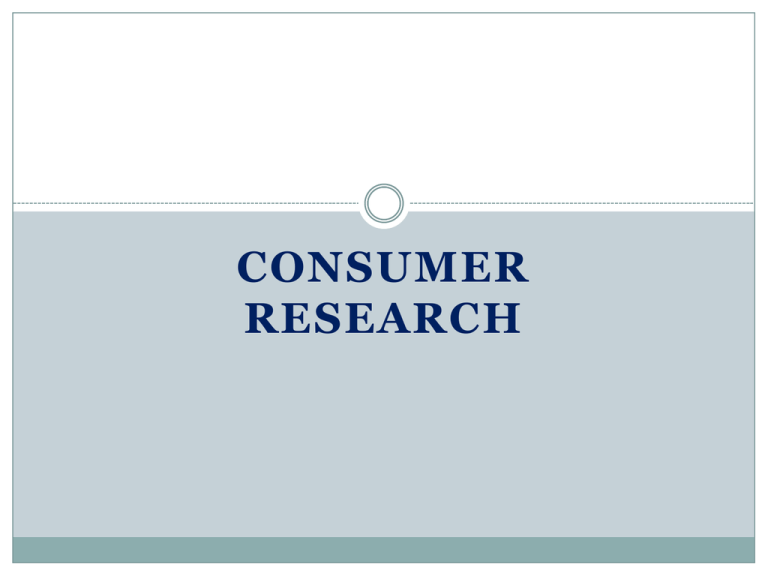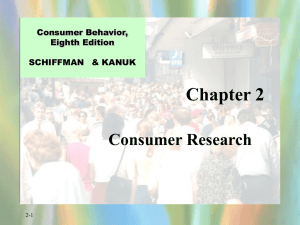
CONSUMER
RESEARCH
Consumer Research Paradigms
Quantitative
Research
Qualitative
Research
Quantitative Research
Descriptive in nature.
Enables marketers to “predict” consumer
behavior.
Research methods include experiments, survey
techniques, and observation.
Findings are descriptive, empirical and
generalizable.
Positivism
A consumer behavior
research approach that
regards the consumer
behavior discipline as an
applied marketing
science. Its main focus is
on consumer decision
making.
Qualitative Research
Consists of depth interviews, focus groups,
metaphor analysis, and projective techniques.
Administered by highly trained intervieweranalysts.
Findings tend to be subjective.
Findings not usually generalizable
Small sample sizes.
Interpretivism
A postmodernist approach
to the study of consumer
behavior that focuses on
the act of consuming
rather than on the act of
buying.
The Consumer Research Process
The six major steps in the consumer research
process are:
defining the objectives of the research
collecting and evaluating secondary data
designing a primary research study
collecting primary data
analyzing the data
preparing a report on the findings
The Consumer Research Process
Develop Objectives
Collect Secondary Data
Design Qualitative Research
• Method
• Screener questionnaire
• Discussion guide
Design Quantitative Research
• Method
• Sample design
• Data collection instrument
Conduct Research
(Using highly trained
interviewers)
Collect Primary Data
(Usually by field staff)
Exploratory
Study
Analyze Data
(Subjective)
Analyze Data
(Objective)
Prepare Report
Prepare report
Developing Research Objectives
Defining purposes and objectives helps
ensure an appropriate research design.
A statement of objectives helps to define
the type and level of information
needed.
Secondary
Data
Data that has been
collected for reasons other
than the specific research
project at hand.
Collecting Secondary Data
Secondary information is any data originally
generated for some purpose other than the
present research objectives.
Provides clues and direction for the design of
primary research.
Primary
Research
Original research
undertaken by individual
researchers or
organizations to meet
specific objectives.
Collected information is
called Primary Data.
Major Sources of Secondary Data
Internal
Sources
Government
Publications
Internal sources include company profit-loss statements, balance sheets,
sales figures, sales-call reports, invoices, inventory records, and prior
research reports.
Statistical Abstract, updated annually, provides summary data on
demographic, economic, social, and other aspects of the American
economy and society.
Country and City Data Book, updated every three years, presents
statistical information for counties, cities, and other geographical units
on populations, education, employment, aggregate and median income,
housing, bank deposits, retail sales, etc.
Marketing Information Guide provides a monthly annotated
bibliography of marketing information.
Other government publications include the Annual Survey of
Manufacturers; Business Statistics; Census of Manufacturers; Census
of Population; Census f Retail Trade, Wholesale Trade, and Selected
Service Industries; Census of Transportation; Federal Reserve
Bulletin; Monthly Labor Review; Survey of Current Business; and
Vital Statistics Report.
Commercial
Data
A.C. Nielsen Company provides data on products and brands
sold through retail outlets (Retail Index Services), data on television
audiences (Media Research Services), magazine circulation data
(Neodata Services, Inc.), etc.
Market Research Corporation of America provides data on
weekly family purchases of consumer products (National Consumer
Panel); data on home food consumption (National Menu Census);
and data on 6,000 retail, drug, and discount retailers in various
geographical areas (Metro Trade Audits).
Selling Areas-Marketing, Inc., provides reports on warehouse
withdrawals to food stores in selected market areas (SAMI reports).
Simmons Market Research Bureau provides annual reports
covering television markets, sporting goods, proprietary drugs, etc.,
giving demographic data by sex, income, age, and brand preferences
(selective markets and media reaching them).
Burke Marketing Services, Inc., provides TV campaign testing
in controlled marketing labs, marketing modeling, retail store
audits, physiological measures of advertising stimuli, pre- and postTV copy testing, and customer survey research.
Markets Facts, Inc., provides consumer mil panel, market teststore audit services, shopping mall facilities, WATS telephone
interviewing, and ad hoc survey research.
Other commercial research houses selling data to subscribers
include the Audit Bureau of Circulation, Audits and Surveys, Dun
and Bradstreet, Opinion Research, Roper-Starch, and Arbitron.
Designing Primary Research
Quantitative studies more likely for collecting
descriptive information.
Qualitative studies may be used to get new
ideas.
Quantitative Research Designs
Method
Sample Design
Data Collection
Instrument
Data Collection Methods
Observation
Experimentation
Surveys
Observational Research
Helps marketers gain an in-depth
understanding of the relationship between
people and products by watching them buying
and using products.
Helps researchers gain a better understanding
of what the product symbolizes.
Widely used by interpretivist researchers.
Experimentation
Can be used to test the relative sales appeal of
many types of variables.
Only one variable is manipulated at a time,
keeping other elements constant.
Can be conducted in laboratories or in the field.
Surveys
Personal Interview
Mail
Telephone
Online
Data Collection Instruments
Questionnaires
Personal
Inventories
Attitude
Scales
Discussion
Guides
Validity
The degree to which a
measurement instrument
accurately reflects what it
is designed to measure.
Reliability
The degree to which a
measurement instrument
is consistent in what it
measures.
Questionnaires
Used primarily for quantitative research.
Can be sent in the mail, or administered by
interviewers in person or by telephone.
Can be disguised or undisguised as to its true
purpose.
Questions can be open-ended or closed-ended.
Attitude Scales
The three most frequently used scales are:
Likert scales: easy for researchers to prepare and
interpret, and simple for consumers to answer.
Semantic differential scales: relatively easy to
construct and administer.
Rank-order scales: subjects rank items in order of
preference in terms of some criteria.
Example of a Likert Scale
Please place the number that best indicates how strongly you agree or disagree
with each of the following statements about shopping on-line in the space to
the left of the statement.
1 = Agree Strongly
2 = Agree
3 = Neither Agree or Disagree
4 = Disagree
5 = Disagree Strongly
_____ a. It is fun to shop online.
_____ b. Products often cost more on-line than they are worth.
_____ c. It is a good way to find out about new products.
_____ d. I’m afraid to give out my credit card number on-line.
_____ e. I can shop whenever I want--even at 2 o’clock in the
morning.
_____ f. Some Web sites really encourage you to browse.
_____ g. It’s easy to compare different makes and models one-line.
Rank-Order Scales
A. Please rank the following e-mail providers in terms of ease of access
by placing a 1 in front of the service you think is best, a 2 alongside
the second best, and continuing until you have ranked all six service
providers.
_____ America Online
_____ Netscape
_____ Microsoft Explorer
_____ AT&T Worldnet
_____ Juno
_____ Erols
B. Rank the following computer manufacturers in terms of hotline help
by placing a 1 next to the one who provides the best telephone help a
2 next to the second best, until you have ranked all six.
_____ IBM
_____ Dell
_____ Compaq
_____Hewlett Packard
_____ Gateway
_____ NEC
Qualitative Data Collection Methods
Depth
Interviews
Focus
Groups
Projective
Techniques
Metaphor
Analysis
Depth Interviews
A lengthy non structured interview between a
respondent and a highly trained interviewer.
Interviewer minimizes his or her own
participation after establishing the general
subject matter.
Can provide marketers with valuable ideas
about product design and provide insights for
positioning or repositioning the product.
Focus
Group
A qualitative research
method in which about
eight to ten persons
participate in an
unstructured group
interview about a product
or service concept.
Focus Groups
Consists of 8 to 10 respondents who meet with
a moderator-analyst for a focused group
discussion.
Respondents encouraged to discuss their
interests, attitudes, reactions, motives,
lifestyles, feelings about the product or
product category, usage experience, etc.
Respondents recruited on the basis of
consumer profiles, based on specifications
defined by marketing management.
Projective
Techniques
Research procedures
designed to identify
consumers’ subconscious
feelings and motivations.
These tests often require
consumers to interpret
ambiguous stimuli such as
incomplete sentences,
cartoons, or inkblots.
Projective Techniques
Consist of a variety of disguised “tests” that
contain ambiguous stimuli.
Sometimes administered as part of a focus
group, but usually used with depth interviews.
The theory is that respondents’ inner feelings
influence how they perceive stimuli.
Metaphor Analysis
Based on belief that metaphors are the most
basic method of thought and communication.
Zaltman Metaphor Elicitation Technique
(ZMET) combines collage research and
metaphor analysis to bring to the surface the
mental models and the major themes or
constructs that drive consumer thinking and
behavior.
Consumer values also play an important role
in understanding consumer behavior.
Sampling Plan Decisions
Whom to
survey?
How many?
How to
select them?
Analysis
Qualitative Research:
Moderator or test administrator
usually analyzes responses.
Quantitative Research:
Researcher supervises the analysis.
Open-ended
responses are coded
and quantified
Responses are tabulated and
analyzed
Conducting A Research Study
Researchers often adapt the research
process to the special needs of the study.
Together with the marketing manager,
the researcher specifies the parameters of
the population to be studied.
A qualitative study might be undertaken
first to gather information about the
target population's attitudes and
concerns about certain items.
Then a quantitative study may be
conducted to confirm and attach “hard”
numbers to the findings.









